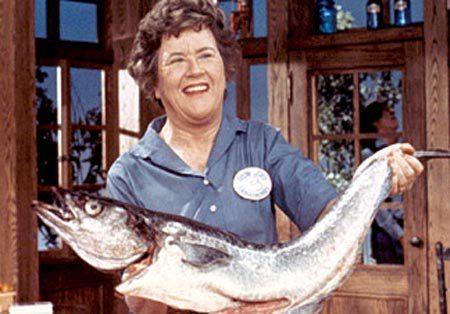Kathleen Flinn's Blog, page 26
August 2, 2012
Join me for a potluck for Julia
 Just a heads up for all Julia Child lovers in Seattle about a cool event in August to celebrate the release of Dearie: The Remarkable Life of Julia Child, a new biography of Julia in which we get to know the real, passionate, quirky woman behind the icon. On August 15, Julia would have been 100 years old. University Book Store in Seattle is hosting a little party to celebrate the woman and the icon. I will be joining some local food writers to share my personal story about meeting Julia (and even show off my own Julia impression) and read from her letters. Also on hand will be some French music and of course, some cake. If you’re in Seattle, bring your favorite dish from Julia to share. Bon appetit!
Just a heads up for all Julia Child lovers in Seattle about a cool event in August to celebrate the release of Dearie: The Remarkable Life of Julia Child, a new biography of Julia in which we get to know the real, passionate, quirky woman behind the icon. On August 15, Julia would have been 100 years old. University Book Store in Seattle is hosting a little party to celebrate the woman and the icon. I will be joining some local food writers to share my personal story about meeting Julia (and even show off my own Julia impression) and read from her letters. Also on hand will be some French music and of course, some cake. If you’re in Seattle, bring your favorite dish from Julia to share. Bon appetit!
If you can’t make the potluck here in town, maybe host your own? The book looks like a great read, too.


July 27, 2012
Review: The Julia Child App
Just in time to celebrate her 100th birthday, a Seattle-based company has released an app featuring 32 recipes from the classic Mastering the Art of French Cooking, plus clips from the DVD version of “The Way to Cook,” plus other content, including excerpts from the book. It’s $2.99 from iTunes and available on the Nook, too.
A lover of all things Julia, I tried it out on the iPad 2. The simple, classy design easily navigates among the 32 recipes. Each provides an image of the finished dish, the ingredients, equipment, tips and a brief video of Julia in action. Rounding out the content is a surprising amount of text lifted directly from Mastering the Art of French Cooking, among them tips on making stock, equipping a kitchen equipment, a primer on wine and even a glossary of cooking terms. There’s also a charming piece by her longtime Knopf editor, Judith Jones, on the story behind the book.
In terms of the recipes themselves, it was a walk down memory lane of my days at Le Cordon Bleu in Paris. The recipes mirror the core curriculum of the Basic Cuisine course. Included are basic sauces such as bechamel, sauce brun and vinaigrette. Then it moves onto classics such as bouef Bourguignon, blanquette de veau, poulet roti, suprêmes de volaille, and pate de canard en croûte.
The videos included are short, yet highly educational snippets from her 1989 series, “The Way to Cook,” now available on DVD. (Judith Jones served as executive producer.) Watching Julia demonstrate searing beef or whisking up a hollandaise reminded me why she was such a great teacher: she was a great explainer with an understated sense of humor who was enthusiastic about every detail of cooking. “When my mother was growing up in the wilds of northern Illinois, you couldn’t get decent lettuce except in summer,” and then it was mostly iceberg, Julia says during her vinaigrette video. Then she exhales, ”We are so lucky now!” and cheerfully showed off a variety of lettuces, including some “lovely” romaine.
While it’s handy to have a great sample of classic recipes together, the videos make this app worthwhile. It’s hard to resist her unspoken cheer of “You can do it!” My husband Mike was ready to pounce on the Vitamix to make a batch of fresh mayonnaise. Or, as Julia said it, maay-OH-naze.
The app has some sweet touches, such as a button that lets you hear Julia say the name of the dish in French. You can hear both her pride and precision as she carefully announces “beouf bourguignon.”
From a functional standpoint, it’s straightforward, with an easy-to-navigate format. (Some users have reported on iTunes that the app runs slowly, or they had trouble with the videos. I didn’t encounter any such problems using it on the iPad 2, but didn’t try it on the iPhone or Nook.) The division of the instruction from the ingredients list requires an extra click, and the length of the recipes means a fair amount of scrolling. This isn’t a problem if you’re browsing, but might be annoying when you’ve got dirty hands and need to have to click or scroll in the middle of making a recipe.
One thing that may feel a bit “dated” to modern cooks is the casual employment of butter – lots of it. After a couple weeks at LCB, I thought nothing of using a stick of butter in a recipe. (I also gained a dozen pounds.) I’ve long since given up using copius doses of butter in my own cooking. While nothing can replace the classic butter-dense Hollandaise sauce the way Julia demonstrates, I lean toward more heart-friendly options, such as this recipe from EatingWell.com.
The bottom line: This doesn’t replace owning a copy of Mastering the Art of French Cooking, but for $2.99, it’s definitely worth it to have a mini French cooking class led by Julia on a device you can actually take shopping and then set on your kitchen counter. If you ever wanted to study at Le Cordon Bleu in Paris, but don’t have the $11,000 USD for the Basic Cuisine course, this inexpensive app offers a great primer. Of course, it also lacks the hands-on instruction from French chef and living in Paris, of course. It’s available for a limited time, so if you want it, go download it now.
If you’re vaguely interested in this app, I highly recommend the
June 28, 2012
Meryl as Julia, Nora Ephron up close
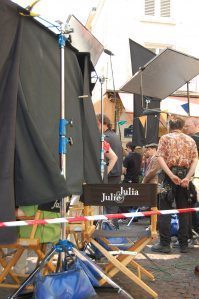 Note from Kat: This was originally posted June 10th, 2008. I’ve reposted it in memory of late Nora Ephron.
Note from Kat: This was originally posted June 10th, 2008. I’ve reposted it in memory of late Nora Ephron.
So yesterday morning, I went down to get a baguette and I ran into Meryl Streep dressed up as Julia Child.
Oh, all right, it wasn’t that straight forward. Actually, yesterday a friend called from the Café Mouffetard where she was having a glass of wine to say that they were setting up for a movie. It turns out they were shooting Julie & Julia. In case you’re unfamiliar, it’s about Julie Powell taking on the task of cooking all of Julia Child’s recipes in Mastering the Art of French Cooking in one year. That’s 524 recipes in 365 days. 
They transformed this small bit of Rue Mouffetard, the famed market street, into a 1950s version of itself for this shoot. We watched transfixed as they wheeled in antique handcarts, scales and even a couple of delivery trucks to set the scene. When I got up this morning, I walked down the two blocks from our apartment to the film set and lo, behold, the whole street was a weird Twilight Zone light transformation. There were extras walking around in 1950s garb, smoking and talking on their mobile phones. It was anarchimism central.
Then I walked around the camera area and bam, there was Nora Ephron. Resplendent in a cream outfit with a hat, big sunglasses and cream-ish pashmina. A small crowd had started milling but yet they were just sitting there, on the street. I was five or six feet away.
 For me, the true celebrity was Nora. I mean, hello, if Nora had not been high maintenance in ordering a salad her whole life, we’d been deprived of key scenes from “When Harry Met Sally…” So I stood by and listened. A friend approached. “Oh, hey, did you change since breakfast? You look so elegant! It could be Venice.” And then, later, debating the price for carrots written on a chalk sign in the scene. “Is 25 francs too much? Hey, so this price thing is an issue. Let’s think. In 1951, there would have been how many francs to the dollar?”
For me, the true celebrity was Nora. I mean, hello, if Nora had not been high maintenance in ordering a salad her whole life, we’d been deprived of key scenes from “When Harry Met Sally…” So I stood by and listened. A friend approached. “Oh, hey, did you change since breakfast? You look so elegant! It could be Venice.” And then, later, debating the price for carrots written on a chalk sign in the scene. “Is 25 francs too much? Hey, so this price thing is an issue. Let’s think. In 1951, there would have been how many francs to the dollar?”Then, boom, Meryl Streep shows up made up as Julia Child. I was standing 10 feet from her and all I can say is that she has remarkable skin. She made a convincing Julia Child. Maybe it was the hair. She definitely had the early hunching posture down. But then, some weird American guy showed up on the sidelines. I can only state two things definitely: 1) He was a gay out-of-work actor and 2) if I were Meryl Streep, I’d be afraid of him.
“I LOVE YOU MERYL!!!” he started screaming at the top of his lungs. The crowd was mostly French. This screaming was very un-French behavior. “Oh my god, it’s her!” He was panting. “I LOVE YOU MERYL!!!” The security guards started standing closer together, in front of the guy, between him and Meryl.
As the other token American in the crowd, I felt the need to talk to him. “Um, that’s probably going to freak everybody on the set out,” I told him. “You might want to stop yelling.”
He seemed pained. “But I love her.” He looked around. We had a pretty good spot right behind the camera. “Do you think they’d make me move? Oh shit, I’m out of film. Damn. Shit. Damn.”
 The Meryl Lover stopped yelling long enough for them to rehearse a scene of her walking down the street a couple times. Eventually, she returned to enclosure where Nora was screening the scenes. “I LOVE YOU MERYL!!!” he started yelling. People physically moved away. He turned to me. “Will you yell with me?” He looked at me through thick glasses. I shook my head. A French woman next to me commented that, for my sake, I should move away. Eventually, he moved on.
The Meryl Lover stopped yelling long enough for them to rehearse a scene of her walking down the street a couple times. Eventually, she returned to enclosure where Nora was screening the scenes. “I LOVE YOU MERYL!!!” he started yelling. People physically moved away. He turned to me. “Will you yell with me?” He looked at me through thick glasses. I shook my head. A French woman next to me commented that, for my sake, I should move away. Eventually, he moved on.We took some photos and waited through a few takes, but there was not much to see around all the cameras. They put up big dark curtains around Nora. We ran errands, went to see a friend and came back as they were starting to break down the set. We watched fake pig heads going by on trolleys, extras stopping into bars for a drink and a slew of people swarm past us. By 7:30 p.m., it was all back to 2008.








June 11, 2012
Reader Q&A: Why Ditch Table Salt?
 I was inspired by The Kitchen Counter Cooking School, but I was wondering why you’re so against iodized table salt? I’ve heard that people need a certain amount of iodine so it is added to salt because it’s impossible to get otherwise. Any clarification would be helpful! – Sally B., Madison, Wis.
I was inspired by The Kitchen Counter Cooking School, but I was wondering why you’re so against iodized table salt? I’ve heard that people need a certain amount of iodine so it is added to salt because it’s impossible to get otherwise. Any clarification would be helpful! – Sally B., Madison, Wis.
Kathleen says: I’ve had a few people ask about this, and even one person posted a comment on the site. So let me clarify. I’m not against iodine in salt, I’m just not a fan of highly processed table salt in which natural trace elements have been stripped out. I recommend unrefined salt for home cooking instead of highly processed table salt. There are many affordable, healthier and ecologically better options out there, as I recently learned from the excellent book Salted by Mark Bitterman.
Unrefined or natural salts, such as mineral or sea salts, contain a variety of trace elements, often mirroring the makeup of these minerals in the body. These include magnesium and potassium, both of which help the body metabolize sodium. Bluntly put, unrefined salt has minerals that help you process the sodium better and flush out what the body doesn’t use.
Refined salt has been through an arduous chemical transformation to strip away these trace minerals to leave it pure white and pure sodi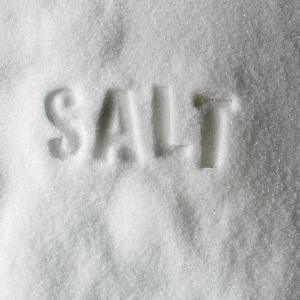 um paired with an anti-caking agent and added iodine . So you get a wee bit of iodine, but none of the trace minerals that help you break down and use the sodium more efficiently. If you’ve had that container of table salt in your cupboard for more than a year, the iodine may have likely evaporated, too.
um paired with an anti-caking agent and added iodine . So you get a wee bit of iodine, but none of the trace minerals that help you break down and use the sodium more efficiently. If you’ve had that container of table salt in your cupboard for more than a year, the iodine may have likely evaporated, too.
Another reader asked, “Why do they strip all the trace mineral elements out of table salt?” Only a single digit of processed salt – about 7% - is used in food or sold to consumers as table salt. The rest is sold for a wide range of industrial applications that require chemically pure sodium chloride. Pure sodium is required to make various pharmaceuticals, baking soda, fertilizer, injection-molded plastics and explosives, among other things.
Why do they add the iodine? Some areas of the world, including the Great Lakes region of the United States, don’t have iodine as a naturally occurring mineral, so in the 1920s salt manufacturers began to add it to fight against disorders related to iodine deficiency, notably thyroid disorders such as goiter and cognitive development in infants and children. But not every area is deficient in iodine; for instance, South Carolina is sometimes referred to as the “iodine state.”
The World Health Organization combats iodine-deficiency by promoting iodized salt globally. In a famine setting, the lack of iodine — among many other nutrients – is a serious health issue. At that point, what salt tastes like or how much it’s refined doesn’t matter.
But in most industrialized countries where people have an adequate diet, there are other options for getting iodine. Some argue that salt isn’t the most effective way to get iodine in your system, and eating foods with iodine are a better bet. Most dairy products contain iodine, as does seafood, kelp and seaweed, such as the kind used in sushi rolls. For the non-seafood eaters, you can also get iodine by eating spinach, asparagus, garlic, strawberries, lima beans, mushrooms, sesame seeds, zucchini, Swiss chard, collard greens and turnip greens. Another option is to take a multi-vitamin with iodine.
I used to advocate kosher salt, but after reading Salted, I learned that it too can be highly processed with most of the minerals stripped out. So I now recommend sea salt or sel gris for daily cooking which includes important minerals that your body needs, notably magnesium, calcium, potassium, and sometimes – depending on the provenance – many more. In my kitchen, I used a variety of salts and one of my standards is Trapani’s a natural sea salt with iodine from Italy.
Try this: Get some table salt and some sea salt. Put them in a bowl and compare the color, texture and taste. This is fun to do with friends; ask them to bring whatever salt they have at home if they’ve got something other than table salt. You don’t have to eat highly processed sodium that doesn’t taste good. Salt is used in such limited quantities in cooking, and life is short. Buy decent salt, get yourself some real flavor and extra minerals.








June 8, 2012
Friday Reads: Women & Cookbooks
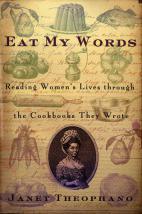 This week, I’m continuing to barrel through research on gin and dining habits of the 1700s. But my research on foods of this era led me to an interesting book that I started a couple of days ago, Eat My Words: Reading Women’s Lives through the Cookbooks they Wrote by Janet Theophano (Palgrave, 2002). It reminded me of another book I read on the subject a few years ago, A Thousand Years over a Hot Stove by Laura Schenone (W.W. Norton, 2004).
This week, I’m continuing to barrel through research on gin and dining habits of the 1700s. But my research on foods of this era led me to an interesting book that I started a couple of days ago, Eat My Words: Reading Women’s Lives through the Cookbooks they Wrote by Janet Theophano (Palgrave, 2002). It reminded me of another book I read on the subject a few years ago, A Thousand Years over a Hot Stove by Laura Schenone (W.W. Norton, 2004). 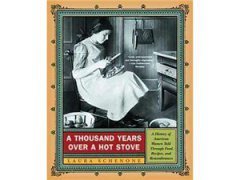 Theophano’s book is more academic than Schenone’s book which was a lively read as well as educational. Both demonstrate that cookbooks are about much more than just food but as Theophano notes, “illustrate a woman’s social interactions” at the time. I’m personally fascinated by culinary history and cookbooks in general, and both of these titles show how eating and recipes shifted over the years, and how the women who wrote them changed as well. It also has a universal message — that becoming a proficient cook can lead to confidence in area outside the kitchen as well. Anyone who has read my second book will know why I highlighted this comment in Eat My Words: “Cookbooks make evident the self-esteem some women developed as their matured in their domestic roles…” while in the past some areas were difficult for women to participate in, domestic pursuits were one in which “women could compete and excel.”
Theophano’s book is more academic than Schenone’s book which was a lively read as well as educational. Both demonstrate that cookbooks are about much more than just food but as Theophano notes, “illustrate a woman’s social interactions” at the time. I’m personally fascinated by culinary history and cookbooks in general, and both of these titles show how eating and recipes shifted over the years, and how the women who wrote them changed as well. It also has a universal message — that becoming a proficient cook can lead to confidence in area outside the kitchen as well. Anyone who has read my second book will know why I highlighted this comment in Eat My Words: “Cookbooks make evident the self-esteem some women developed as their matured in their domestic roles…” while in the past some areas were difficult for women to participate in, domestic pursuits were one in which “women could compete and excel.” 
I also started to read To Kill a Mockingbird by Harper Lee to study the pacing and the language of her work. She also had such a natural way with dialogue and character development. I find that reading a great book while trying to do a lot of writing myself inspires me to write even more. Does that make any sense?








June 4, 2012
Reader Mail: How to Cut an Onion?
 My book club read The Sharper Your Knife and we all loved it. So I got a copy of The Kitchen Counter Cooking School and I was so inspired, I went ahead and got the chef’s knife from block set we received as a wedding gift 11 years ago sharpened for the first time! I’ve read through your description on how to cut an onion, but I think I’m doing something wrong. Do you have any photos of this process online anywhere? Heather C., Houston
My book club read The Sharper Your Knife and we all loved it. So I got a copy of The Kitchen Counter Cooking School and I was so inspired, I went ahead and got the chef’s knife from block set we received as a wedding gift 11 years ago sharpened for the first time! I’ve read through your description on how to cut an onion, but I think I’m doing something wrong. Do you have any photos of this process online anywhere? Heather C., Houston
Kathleen says: Ah, it warms my heart to hear about people getting their knives out in the kitchen. As it happens, I have a video we made last summer in which I demonstrate basic knife skills, including the way the chefs at Le Cordon Bleu showed me how to chop an onion. You can also go to the cooking lessons page for a free video on knife skills from Rouxbe.com.









June 1, 2012
Friday Reads: Birthday Edition
June 1 is my birthday. Today, I’m in Florida watching it rain in buckets outside our little house on Anna Maria Island, and for that I’m grateful. While the West Coast has been pummeled with all kinds of rainfall, somehow it keeps missing the island and I’ve sat watching my plant seize up and start to wither under the oppressive heat. So, I’m looking at the wet clothes sagging on the laundry line, listening to the cacophony of pounding rain on our flat roof and clatter like a waterfall from the gutter that ends abruptly in front of my window in front of my desk.
With that, I’m back to biscuits.
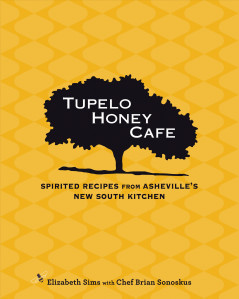 I’ve been paging through the cookbook from Tupelo Honey Café all week, thinking about some kind of perilously rich and generally forbidden heavy southern food for my birthday lunch. My mom and I ate at the Café in Asheville, N.C., when she joined me for a book tour event at the great independent bookstore Malaprops last autumn. We made a whole weekend out of it, and ended up going to see the Biltmore Estate decked out for the holidays. We spent hours wandering around charming downtown. But mostly, I remember the huge biscuits and the sausage gravy from the Tupelo Honey Cafe. So I’ve been eyeing them and reading through this beautiful cookbook by Elizabeth Sims with Chef Brian Sonoskus all week in contemplation. In one glossy book, you get a mix of Asheville’s history plus a bit of detail on culinary influences and traditions from across the American south. The recipes offer a sense of the playful, forward-thinking yet faithful to tradition cuisine that Sonoskus brings to his menus. Cilantro lime mayonnaise sits next to a southern fried chicken BLT, while shrimp and grits gets a makeover with a roasted red pepper sauce. Southern fried chicken get paired with cremini mushroom and sweet onion gravy.
I’ve been paging through the cookbook from Tupelo Honey Café all week, thinking about some kind of perilously rich and generally forbidden heavy southern food for my birthday lunch. My mom and I ate at the Café in Asheville, N.C., when she joined me for a book tour event at the great independent bookstore Malaprops last autumn. We made a whole weekend out of it, and ended up going to see the Biltmore Estate decked out for the holidays. We spent hours wandering around charming downtown. But mostly, I remember the huge biscuits and the sausage gravy from the Tupelo Honey Cafe. So I’ve been eyeing them and reading through this beautiful cookbook by Elizabeth Sims with Chef Brian Sonoskus all week in contemplation. In one glossy book, you get a mix of Asheville’s history plus a bit of detail on culinary influences and traditions from across the American south. The recipes offer a sense of the playful, forward-thinking yet faithful to tradition cuisine that Sonoskus brings to his menus. Cilantro lime mayonnaise sits next to a southern fried chicken BLT, while shrimp and grits gets a makeover with a roasted red pepper sauce. Southern fried chicken get paired with cremini mushroom and sweet onion gravy.
The next book is completely unrelated. Let me see if I can stop looking at biscuits or fried chicken long enough to describe it.
 All week, we’ve been taking turns analyzing ourselves, friends and relatives with one of the most intriguing books I’ve ever owned, The Secret Language of Birthdays. Forget those slim horoscopes in the newspaper. This is an oversized book that has two full pages dedicated to each day of the year. Every day has its own title. For instance, I am born “On the Day of the Popular Eye.” (What that means exactly, I’m not sure). It goes into significant detail about the characteristics of those born on any given day, plus traditional strengths and weaknesses. My strengths (says the book): “Visually perceptive. Shrewd. Fun.” My weaknesses? “Tempermental. Distracted. Impatient.” (Mike would completely agree on those.) My meditation: “Living is a creative act.”
All week, we’ve been taking turns analyzing ourselves, friends and relatives with one of the most intriguing books I’ve ever owned, The Secret Language of Birthdays. Forget those slim horoscopes in the newspaper. This is an oversized book that has two full pages dedicated to each day of the year. Every day has its own title. For instance, I am born “On the Day of the Popular Eye.” (What that means exactly, I’m not sure). It goes into significant detail about the characteristics of those born on any given day, plus traditional strengths and weaknesses. My strengths (says the book): “Visually perceptive. Shrewd. Fun.” My weaknesses? “Tempermental. Distracted. Impatient.” (Mike would completely agree on those.) My meditation: “Living is a creative act.”
We spent the week debating whether one day’s descrption matches the person intended. In my case, there’s this passage: “June 1 people must find the courage, at some point in their lives, to dig deep within themselves, when they find out who they really are and what it is they want, they may have no choice but to pursue their dreams regardless of what society, parents or friends think.” Pretty much sums up the story in The Sharper Your Knife, the Less You Cry.








May 25, 2012
Friday Reads: Old London, Miami Spice
My Friday reads may feel a bit light, but I’ve actually been reading more than usual because I’ve got not one, but two manuscripts by close friends that I’ve been reading this week. The voice and the plotlines couldn’t be more different. One is a lyrical tale about a woman who goes to Mumbai to find her long-lost grandfather and learns to cook from him. The other is a study in wry wit as it tells the tale of confederate officer who makes a deal with a demon in a cave who (unsurprisingly) lives to regret it.
 I’m continuing research on the book, and so I’ve been reading Elizabeth’s London: Everyday Life in Elizabethan London by Liza Picard. From bear baiting to cock fighting to the etiquette in wealthy households to how they managed the trash and why the heck they wore those ruffs around their neck, it’s a captivating portrait of life in 16th Century London. One thing that struck me as hard to fathom is that more than half the city’s population was under 25; much of the hard labor was done by teens. Most of the poor were dead by age 30, and only wealthy men and women tended to reach 40, known as the “start of one’s old age” thanks to many ways in which one could perish, not counting the plague.
I’m continuing research on the book, and so I’ve been reading Elizabeth’s London: Everyday Life in Elizabethan London by Liza Picard. From bear baiting to cock fighting to the etiquette in wealthy households to how they managed the trash and why the heck they wore those ruffs around their neck, it’s a captivating portrait of life in 16th Century London. One thing that struck me as hard to fathom is that more than half the city’s population was under 25; much of the hard labor was done by teens. Most of the poor were dead by age 30, and only wealthy men and women tended to reach 40, known as the “start of one’s old age” thanks to many ways in which one could perish, not counting the plague.
 For contrast, I’m reading another of the author’s works, Dr. Johnson’s London: Coffee-Houses and Climbing Boys, Medicine, Toothpaste and Gin, Poverty and Press Gangings, Freakshows and Female Education. This book picks up what happening in the city in the early 1700s, with the development of Westminster (including Covent Garden and Soho, my former stomping grounds). I’m a total history geek, and I’ve read plenty of books on various time periods and Liza Picard’s voice is a breath of fresh air in the genre; light, with a gentle sense of humor and keen eye for irony.
For contrast, I’m reading another of the author’s works, Dr. Johnson’s London: Coffee-Houses and Climbing Boys, Medicine, Toothpaste and Gin, Poverty and Press Gangings, Freakshows and Female Education. This book picks up what happening in the city in the early 1700s, with the development of Westminster (including Covent Garden and Soho, my former stomping grounds). I’m a total history geek, and I’ve read plenty of books on various time periods and Liza Picard’s voice is a breath of fresh air in the genre; light, with a gentle sense of humor and keen eye for irony.
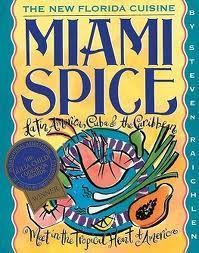 Finally, we arrived in Florida on Wednesday to visit family and friends and to celebrate my birthday next week. So I cracked open Miami Spice by Steven Raichlen, a classic in the annals of Florida cookbooks, for his “Soupy Black Beans” recipe that I’m making to go along with some “Yellow Brown Rice,” essentially brown rice seasoned like traditional Spanish rice. As I flipped through my goop-splattered copy, I was reminded how much of an impact this book had on me when I came across it in the books submitted to the features department at the Sarasota Herald-Tribune newsroom. I had grown up in Florida and never appreciated the impact and influence of Cuban, Latin America and Caribbean influence on the cuisine here. I convinced the features editor to let me write a story about it, no small task since I think I was still writing obituaries at the time. So it was the first cookbook that I covered in my fledging food writing days, which also means Steven was the first cookbook author I actually talked to. I remember being wildly nervous about it, but he was both polite and - since it was his first book - eager to talk about it. That book dropped me into a world of jerk chicken, smoked gazpacho and rice spiked with coconut milk – all of which sounds so good right now, I think I’ll make them this weekend.
Finally, we arrived in Florida on Wednesday to visit family and friends and to celebrate my birthday next week. So I cracked open Miami Spice by Steven Raichlen, a classic in the annals of Florida cookbooks, for his “Soupy Black Beans” recipe that I’m making to go along with some “Yellow Brown Rice,” essentially brown rice seasoned like traditional Spanish rice. As I flipped through my goop-splattered copy, I was reminded how much of an impact this book had on me when I came across it in the books submitted to the features department at the Sarasota Herald-Tribune newsroom. I had grown up in Florida and never appreciated the impact and influence of Cuban, Latin America and Caribbean influence on the cuisine here. I convinced the features editor to let me write a story about it, no small task since I think I was still writing obituaries at the time. So it was the first cookbook that I covered in my fledging food writing days, which also means Steven was the first cookbook author I actually talked to. I remember being wildly nervous about it, but he was both polite and - since it was his first book - eager to talk about it. That book dropped me into a world of jerk chicken, smoked gazpacho and rice spiked with coconut milk – all of which sounds so good right now, I think I’ll make them this weekend.








May 21, 2012
Reader Mail: How to Outfit a Kitchen on a Budget or 14 Things Every Kitchen Needs
I get a fair amount of reader mail and I do my best to answer everyone quite quickly and thoroughly. Recently, I realized that readers often bring up great questions and so I thought I’d start answering them regularly here on the blog. Here’s the first one.
 “In your book I like how you were able to show how people with different lifestyles were able to take on cooking successfully and even give people shopping strategies to stretch their dollar. While you have done a great job in showing how accessible cooking really is, I feel as if you missed one thing. The essential tools for a kitchen. Do you have any thoughts, especially for those trying to stock one on a budget? Thanks, Benito“
“In your book I like how you were able to show how people with different lifestyles were able to take on cooking successfully and even give people shopping strategies to stretch their dollar. While you have done a great job in showing how accessible cooking really is, I feel as if you missed one thing. The essential tools for a kitchen. Do you have any thoughts, especially for those trying to stock one on a budget? Thanks, Benito“
Kathleen says: Thanks for the great question, Benito. I’ve put together a very general guide that I’ve used for events aimed at college students, and you’ll find the list below. People have been quite successful making a lot of food in the past centuries with little more than a pot, spoon, bowl, knife and cutting surface. My niece Michelle recently moved into her first apartment, and this whole concept became quite real when we look at her bare cupboards and had to think, “What does she really need?” and “How does she equip this for the least money but at good value?”
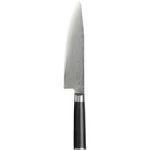 A Good Chef’s Knife
A Good Chef’s Knife
Don’t waste money on a cheap knife block set. The quality is not good, and you’ll get a bunch of knives you’ll never use. Start with a chef’s knife, usually around eight-inches but this can vary by your size and your hands. I always suggest going to a store that will allow you handle the knife first. What you’re after is what I call “the steel and the feel.” If it’s uncomfortable, you won’t want to use it. It should have a blade of good enough quality that it can take an edge and keep it. After your chef’s knife, follow it up with a 10-inch bread knife and a small paring knife. Try not to skimp, and get one that feels good in your hand. Never put a knife in the dishwasher; the detergent will dull the blade, the heat from the steam may warp it and neither will do much for the handle, either.
IKEA makes a decent (if not long lasting) chef’s knife for $10, and Victorinox makes a high-carbon steel one for about $30, but you’ll be replacing both in a couple years. You can find great deals at restaurant supply stores and at the business-focused Costco outlets. If you want to splurge, explore mid-range options from German or Japanese knife manufacturers such as Henckels, Wusthof and Global. Avoid their very cheapest, entry-level goods, though; at that point, you tend to be paying more for the name brand than the quality of knife. If you invest in a knife and treat it well by hand washing it and getting it regularly sharpened, it can last a lifetime.
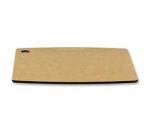 Cutting Board (or two)
Cutting Board (or two)
A good-looking cutting board can double as a serving platter for parties. If you’ve got two, you can use one for meat during food prep. Avoid glass; it has a grating sound and will ruin your blade.
My favorite kind of cutting board is the Epicurean-brand variety made from recycled paper looks great, it can go into the dishwasher and will last for years ($24), so it’s eco-friendly and a value. Next up are cutting boards made from bamboo. They’re inexpensive, look good, and are also eco-friendly. Just don’t put them in the dishwasher; wash them by hand and let air dry. A large inexpensive cutting board such as food-grade plastic can be had for little money and I prefer to use these for meat or fish preparation since they can be sanitized in the dishwasher; just be aware that they tend to warp over time ($12). Wooden cutting boards are handsome, but need a little extra care. ($30+).
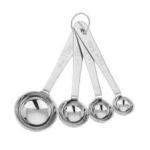 Measuring cups and spoons
Measuring cups and spoons
Stick with basic metal measuring cups and spoons to start. You’ll find good deals from IKEA, a warehouse store or online, but note that you can often find them at Goodwill or Salvation Army stores with a decent housewares section for as little as a $1 each.
Hot pot or electric kettle
A hot pot or kettle is great for rapidly boiling water. Whether you use it to brew a cup of tea, get a jump on water for pasta, or cook even ramen noodles. You’ll find one can find a thousand and one potential uses for it. ($13+)
Can opener
Go a step up from the hand killer $2 version and get a heavier one that works that won’t destroy a can or leave dangerously sharp edges.
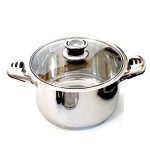 A large heavy-bottomed pot
A large heavy-bottomed pot
A six- to eight-quart heavy bottom pot will keep you from burning everything you put into it, and will allow for an even sauté onions and vegetables, thus making this a good choice for soup, beans, chili, stock, etc. in addition to using it for boiling water for pasta or steaming vegetables. You can get an inexpensive stainless one from IKEA or a restaurant supply store. Just avoid a thin non-stick version or aluminum, both of which will leach stuff you don’t want into your food and will generally be too thin to do anything other than boil water.
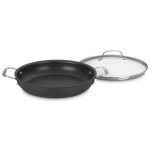 A 3-quart heavy skillet or sauté pan
A 3-quart heavy skillet or sauté pan
Food writer Michael Ruhlman made this observation in his book The Elements of Cooking: “I can’t think of anything less useful in a kitchen than a cheap non-stick pan.” I agree. Get one that is at least three quarts, and preferably stainless steel, cast iron or a quality non-stick, such as this “everyday pan.” When taken care of, both types will last for years. Be sure to get one that has no plastic in its design (including the handle) so that it can go into the oven, far-extending its value beyond the stove top. Avoid non-stick which limits its use and can’t be used over anything other than low- to moderate-heat and will eventually need to be discarded.
A cast-iron s killet (or this awesome combo set) with can be purchased for about $25 and has the bonus of being great for roasting a chicken, making a casserole or baking bread in the oven. Follow directions for cleaning it and you’ll have it for years. Or, hit a restaurant supply store or a Costco business center and spend $30 on the same kind of pans used in restaurants. If splurging, go directly to a quality brand such as All-Clad. Sure it’s $150 for a 3-quart sauté pan with lid, but if take care of it, you won’t ever have to buy another one.
killet (or this awesome combo set) with can be purchased for about $25 and has the bonus of being great for roasting a chicken, making a casserole or baking bread in the oven. Follow directions for cleaning it and you’ll have it for years. Or, hit a restaurant supply store or a Costco business center and spend $30 on the same kind of pans used in restaurants. If splurging, go directly to a quality brand such as All-Clad. Sure it’s $150 for a 3-quart sauté pan with lid, but if take care of it, you won’t ever have to buy another one.
Colander
A colander ensures you don’t burn yourself trying to drain pasta or while making stock, plus you can use it to wash fresh produce or as a fruit bowl for the table. If you can find a mesh one, it’s even more useful. They often found at thrift stores for a buck.
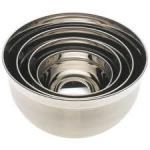 A set of nesting bowls
A set of nesting bowls
You need at least one large bowl to mix stuff in. Consider buying a set of different-sized bowls that nestle into one another. You’ll have multiple options without taking up too much space. Glass or stainless steel are your best investment; avoid plastic as you won’t want to put anything hot (such as freshly made stock) into them and they may stain. Tip: Both glass and stainless steel bowls of varying sizes can often be found for $1 each at Goodwill, and restaurant supply places carry new ones inexpensively, too.
Utensils
Start with a large spoon. Add a silicon spatula ($4), a vegetable peeler and then a good set of tongs such as those made by Oxo ($8). Add a microplaner/grater. After that, what you cook will help you determine what you need such as whisks, ladles, etc. When we stocked up my niece’s apartment, we bought most of her large spoons, spatulas, whisks, a pasta separator, a vegetable peeler etc. at a Goodwill in Seattle for 69 cents each.
A baking or casserole dish
Great for casseroles, lasagna, quiches, pot pies, brownies or small cakes, plus even roasting a chicken, a small yet heavy baking dish is a great place to start when cooking for one or two people. Consider a square glass one to start, and go with stoneware, glass or ceramic for the most functionality, or commercial stainless steel version (often referred to as a “hotel pan”) at a restaurant supply store. ($12 to $45)
 Side towels, oven mitts
Side towels, oven mitts
A couple of side towels are handy, too; many restaurants and culinary schools use quality cloth diapers since they’re cheap and they have a padded center and can double as a heat pad. I’m a fan of getting a decent pair of oven mitts if you use an oven regularly. Just check their heat resistant; anything less than 400 F isn’t worth buying. You can use an oven mitt as a trivet, too, once something hot has to go onto a table.
Plenty of storage for leftovers
Keep plastic and glass containers from takeout, restaurant leftovers and various food purchases In addition to preventing food from going to waste, you can also store foods you can buy in bulk, such as cereal, spices, flour, sugar, oatmeal, nuts, spices, etc. Plus, a glass jar is great for making vinaigrette. When on a budget, no food should be left to spoil as wasted food is wasted money.
Any other thoughts?








Reader Mail: How to Outfit a Modest Kitchen?
I get a fair amount of reader mail and I do my best to answer everyone quite quickly and thoroughly. Recently, I realized that readers often bring up great questions and so I thought I’d start answering them regularly here on the blog. Here’s the first one.
 “In your book I like how you were able to show how people with different lifestyles were able to take on cooking successfully and even give people shopping strategies to stretch their dollar. While you have done a great job in showing how accessible cooking really is, I feel as if you missed one thing. The essential tools for a kitchen. Do you have any thoughts, especially for those trying to stock one on a budget? Thanks, Benito“
“In your book I like how you were able to show how people with different lifestyles were able to take on cooking successfully and even give people shopping strategies to stretch their dollar. While you have done a great job in showing how accessible cooking really is, I feel as if you missed one thing. The essential tools for a kitchen. Do you have any thoughts, especially for those trying to stock one on a budget? Thanks, Benito“
Kathleen says: Thanks for the great question, Benito. I’ve put together a very general guide that I’ve used for events aimed at college students, and you’ll find the list below. People have been quite successful making a lot of food in the past centuries with little more than a pot, spoon, bowl, knife and cutting surface. My niece Michelle recently moved into her first apartment, and this whole concept became quite real when we look at her bare cupboards and had to think, “What does she really need?” and “How does she equip this for the least money but at good value?”
 A Good Chef’s Knife
A Good Chef’s Knife
Don’t waste money on a cheap knife block set. The quality is not good, and you’ll get a bunch of knives you’ll never use. Start with a chef’s knife, usually around eight-inches but this can vary by your size and your hands. I always suggest going to a store that will allow you handle the knife first. What you’re after is what I call “the steel and the feel.” If it’s uncomfortable, you won’t want to use it. It should have a blade of good enough quality that it can take an edge and keep it. After your chef’s knife, follow it up with a 10-inch bread knife and a small paring knife. Try not to skimp, and get one that feels good in your hand. Never put a knife in the dishwasher; the detergent will dull the blade, the heat from the steam may warp it and neither will do much for the handle, either.
IKEA makes a decent (if not long lasting) chef’s knife for $10, and Victorinox makes a high-carbon steel one for about $30, but you’ll be replacing both in a couple years. You can find great deals at restaurant supply stores and at the business-focused Costco outlets. If you want to splurge, explore mid-range options from German or Japanese knife manufacturers such as Henckels, Wusthof and Global. Avoid their very cheapest, entry-level goods, though; at that point, you tend to be paying more for the name brand than the quality of knife. If you invest in a knife and treat it well by hand washing it and getting it regularly sharpened, it can last a lifetime.
 Cutting Board (or two)
Cutting Board (or two)
A good-looking cutting board can double as a serving platter for parties. If you’ve got two, you can use one for meat during food prep. Avoid glass; it has a grating sound and will ruin your blade.
My favorite kind of cutting board is the Epicurean-brand variety made from recycled paper looks great, it can go into the dishwasher and will last for years ($24), so it’s eco-friendly and a value. Next up are cutting boards made from bamboo. They’re inexpensive, look good, and are also eco-friendly. Just don’t put them in the dishwasher; wash them by hand and let air dry. A large inexpensive cutting board such as food-grade plastic can be had for little money and I prefer to use these for meat or fish preparation since they can be sanitized in the dishwasher; just be aware that they tend to warp over time ($12). Wooden cutting boards are handsome, but need a little extra care. ($30+).
 Measuring cups and spoons
Measuring cups and spoons
Stick with basic metal measuring cups and spoons to start. You’ll find good deals from IKEA, a warehouse store or online, but note that you can often find them at Goodwill or Salvation Army stores with a decent housewares section for as little as a $1 each.
Hot pot or electric kettle
A hot pot or kettle is great for rapidly boiling water. Whether you use it to brew a cup of tea, get a jump on water for pasta, or cook even ramen noodles. You’ll find one can find a thousand and one potential uses for it. ($13+)
Can opener
Go a step up from the hand killer $2 version and get a heavier one that works that won’t destroy a can or leave dangerously sharp edges.
A large heavy-bottomed pot
A six- to eight-quart heavy bottom pot will keep you from burning everything you put into it, and will allow for an even sauté onions and vegetables, thus making this a good choice for soup, beans, chili, stock, etc. in addition to using it for boiling water for pasta or steaming vegetables. You can get an inexpensive stainless one from IKEA or a restaurant supply store. Just avoid a thin non-stick version or aluminum, both of which will leach stuff you don’t want into your food and will generally be too thin to do anything other than boil water.
 A 3-quart heavy skillet or sauté pan
A 3-quart heavy skillet or sauté pan
Food writer Michael Ruhlman made this observation in his book The Elements of Cooking: “I can’t think of anything less useful in a kitchen than a cheap non-stick pan.” I agree. Get one that is at least three quarts, and preferably stainless steel or cast iron. When taken care of, both types will last for years. Be sure to get one that has no plastic in its design (including the handle) so that it can go into the oven, far-extending its value beyond the stove top. Avoid non-stick which limits its use and can’t be used over anything other than low- to moderate-heat and will eventually need to be discarded.
A cast-iron skillet (or this awesome combo set) with can be purchased for about $25 and has the bonus of being great for roasting a chicken, making a casserole or baking bread in the oven. Follow directions for cleaning it and you’ll have it for years. Or, hit a restaurant supply store or a Costco business center and spend $30 on the same kind of pans used in restaurants. If splurging, go directly to a quality brand such as All-Clad. Sure it’s $150 for a 3-quart sauté pan with lid, but if take care of it, you won’t ever have to buy another one.
Colander
A colander ensures you don’t burn yourself trying to drain pasta or while making stock, plus you can use it to wash fresh produce or as a fruit bowl for the table. If you can find a mesh one, it’s even more useful. They often found at thrift stores for a buck.
 A set of nesting bowls
A set of nesting bowls
You need at least one large bowl to mix stuff in. Consider buying a set of different-sized bowls that nestle into one another. You’ll have multiple options without taking up too much space. Glass or stainless steel are your best investment; avoid plastic as you won’t want to put anything hot (such as freshly made stock) into them and they may stain. Tip: Both glass and stainless steel bowls of varying sizes can often be found for $1 each at Goodwill, and restaurant supply places carry new ones inexpensively, too.
Utensils
Start with a large spoon. Add a silicon spatula ($4), a vegetable peeler and then a good set of tongs such as those made by Oxo ($8). Add a microplaner/grater. After that, what you cook will help you determine what you need such as whisks, ladles, etc. When we stocked up my niece’s apartment, we bought most of her large spoons, spatulas, whisks, a pasta separator, a vegetable peeler etc. at a Goodwill in Seattle for 69 cents each.
A baking or casserole dish
Great for casseroles, lasagna, quiches, pot pies, brownies or small cakes, plus even roasting a chicken, a small yet heavy baking dish is a great place to start when cooking for one or two people. Consider a square glass one to start, and go with stoneware, glass or ceramic for the most functionality, or commercial stainless steel version (often referred to as a “hotel pan”) at a restaurant supply store. ($12 to $45)
 Side towels, oven mitts
Side towels, oven mitts
A couple of side towels are handy, too; many restaurants and culinary schools use quality cloth diapers since they’re cheap and they have a padded center and can double as a heat pad. I’m a fan of getting a decent pair of oven mitts if you use an oven regularly. Just check their heat resistant; anything less than 400 F isn’t worth buying. You can use an oven mitt as a trivet, too, once something hot has to go onto a table.
Plenty of storage for leftovers
Keep plastic and glass containers from takeout, restaurant leftovers and various food purchases In addition to preventing food from going to waste, you can also store foods you can buy in bulk, such as cereal, spices, flour, sugar, oatmeal, nuts, spices, etc. Plus, a glass jar is great for making vinaigrette. When on a budget, no food should be left to spoil as wasted food is wasted money.
Any other thoughts?









